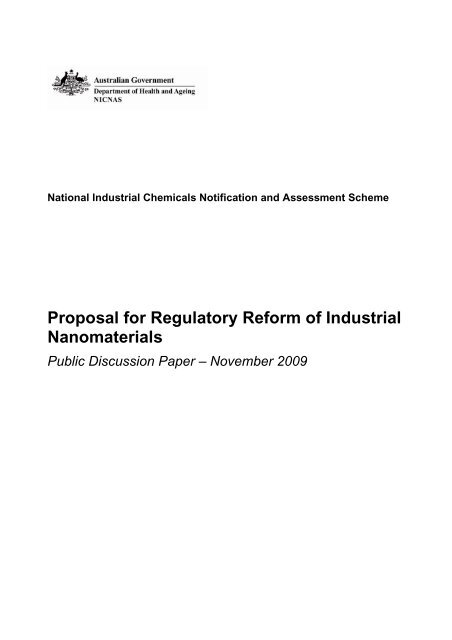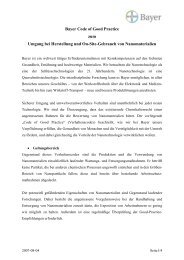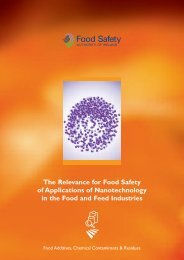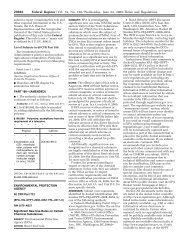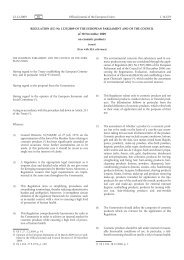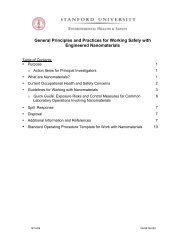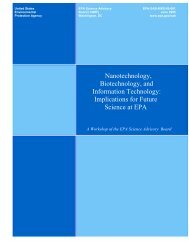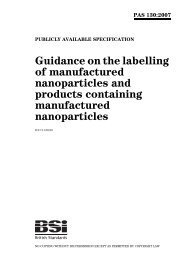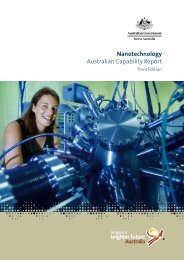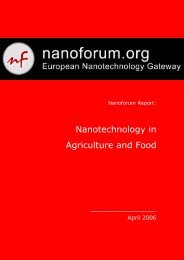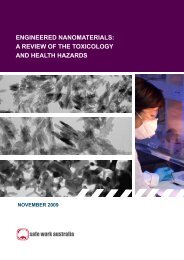Proposal for Regulatory Reform of Industrial Nanomaterials
Proposal for Regulatory Reform of Industrial Nanomaterials
Proposal for Regulatory Reform of Industrial Nanomaterials
You also want an ePaper? Increase the reach of your titles
YUMPU automatically turns print PDFs into web optimized ePapers that Google loves.
National <strong>Industrial</strong> Chemicals Notification and Assessment Scheme<strong>Proposal</strong> <strong>for</strong> <strong>Regulatory</strong> Re<strong>for</strong>m <strong>of</strong> <strong>Industrial</strong><strong>Nanomaterials</strong>Public Discussion Paper – November 2009
CONTENTSPage2 Part OneWhat is the Public Discussion Paper <strong>for</strong> the <strong>Regulatory</strong> Re<strong>for</strong>m <strong>of</strong> <strong>Industrial</strong><strong>Nanomaterials</strong>?1A Purpose <strong>of</strong> this paper1B How to read this paper1C What should you do?4 Part TwoObjectives <strong>of</strong> the <strong>Regulatory</strong> Re<strong>for</strong>m Package <strong>for</strong> <strong>Industrial</strong> <strong>Nanomaterials</strong>2A Objectives <strong>of</strong> re<strong>for</strong>m2B What are industrial nanomaterials?2C What is the current regulatory environment <strong>for</strong> industrialnanomaterials?2D National and international activities in relation to regulation <strong>of</strong>nanomaterials7 Part Three<strong>Industrial</strong> Nanomaterial Re<strong>for</strong>m Options3A Regulation <strong>of</strong> nano<strong>for</strong>ms <strong>of</strong> ‘new chemicals’3B Regulation <strong>of</strong> nano<strong>for</strong>ms <strong>of</strong> ‘existing chemicals3C The principle <strong>of</strong> an integrated approach <strong>for</strong> industrial nanomaterialswithin the NICNAS framework <strong>for</strong> a longer term strategy.17 Part FourNext steps4A4BMaking your response count.What lies ahead?18 Further Reading List19 Glossary20 List <strong>of</strong> Attachments1
PART ONEWhat is the Public Discussion Paper <strong>for</strong> the<strong>Regulatory</strong> Re<strong>for</strong>m <strong>of</strong> <strong>Industrial</strong> <strong>Nanomaterials</strong>?This part outlines the purpose <strong>of</strong> this paper and what to do with it.1APurpose <strong>of</strong> this public discussion paperThis paper provides NICNAS’s stakeholders (the community, industry and government) with theopportunity to comment to NICNAS on a re<strong>for</strong>m initiative to introduce new approaches to the regulation<strong>of</strong> industrial nanomaterials.The proposal utilises the existing NICNAS framework, and proposes some adjustments to addressuncertainties in potential risks posed by these novel materials to health, safety and the environment.NICNAS has a specific role in the overall regulatory framework <strong>for</strong> industrial chemicals in Australia,under legislation provided by the <strong>Industrial</strong> Chemical (Notification and Assessment) Act 1989 (The Act).Other government agencies are responsible <strong>for</strong> regulation <strong>of</strong> nanomaterials in medicines, food,pesticides and veterinary medicines.We invite you to make comment on the overall proposal and in some cases on specific options/initiativesdetailed in Part 3 <strong>of</strong> this Discussion Paper.The proposal addresses three elements;• Regulation <strong>of</strong> nano<strong>for</strong>ms <strong>of</strong> new chemicals;• Regulation <strong>of</strong> nano<strong>for</strong>ms <strong>of</strong> existing chemicals;• The principle <strong>of</strong> an integrated approach <strong>for</strong> industrial nanomaterials within the NICNAS framework asa longer term strategy.In particular, noting the NICNAS’s guiding principles <strong>for</strong> managing risks posed by new technologies(Attachment 1) we are seeking your input as to whether:• this strategy provides <strong>for</strong> the sound management <strong>of</strong> industrial nanomaterials;• the options meet the needs <strong>of</strong> all stakeholders to have confidence in the regulatory system throughprotecting human health and the environment and by providing a clear regulatory path <strong>for</strong> industry;• there are other options which could be considered; and• any imposts on industry are balanced against the objectives <strong>of</strong> government and the expectations <strong>of</strong>the community to ensure public health, worker safety and environmental standards are maintained.At this stage we are specifically seeking your;• input on the options contained in Part 3a and Part 3b <strong>of</strong> this paper, and;• input on the principle <strong>of</strong> an integrated approach <strong>for</strong> industrial nanomaterials within the NICNASframework as a longer term strategy.Supporting in<strong>for</strong>mation <strong>for</strong> comments should be provided. This will facilitate identification <strong>of</strong> potentialimpacts associated with these measures and enable NICNAS to properly weigh the advantages anddisadvantages associated with such changes.Further opportunities will occur <strong>for</strong> input into the regulatory impact assessment as well as consultation onthe development and progression <strong>of</strong> regulatory re<strong>for</strong>m options.2
1BHow to read this paperWith more facts…This Discussion Paper has been compiled to present a proposal to a broad audience.To increase the clarity and readability <strong>of</strong> this paper, details on specific aspects have been provided asAttachments. To indicate when more in<strong>for</strong>mation has been attached on a particular subject, areference is made to the relevant attachment in the text. You can choose to go directly to thatdocument or read it later, depending on your preference.A Further Reading List on relevant issues is hyperlinked in the text and the URLs are also included atthe end <strong>of</strong> this Paper. Links may also be also found on the NICNAS website.With a questionnaire - we want to know what you think!Have your say. The purpose <strong>of</strong> this paper is to get feedback. What do you think <strong>of</strong> this proposal? How willit affect you?The Have Your Say Questionnaire, supplied with this Paper, can be used to express comments andopinions on topics throughout the paper <strong>for</strong> NICNAS’s attention. This questionnaire correlates to questionsasked throughout this Discussion Paper at the appropriate sections and is intended <strong>for</strong> all stakeholdersthat want to provide a written submission.A Business Impact Survey.Will these changes affect your business? If so, we need to know. A Business Impact Survey, suppliedwith this paper, is <strong>for</strong> those stakeholders whose business interests may potentially be impacted.This may be submitted with the Have Your Say Questionnaire, or on its own. This has been designedaccording to the Office <strong>of</strong> Best Practice Regulation (OBPR) guidelines to assist us with a Preliminary<strong>Regulatory</strong> Impact Assessment.Please note:All submissions will be placed on the NICNAS website. For submissions made by individuals, all personaldetails other than your name will be removed from your submission be<strong>for</strong>e it is published on the NICNASwebsite. Confidential material contained within submissions should be clearly marked. Reasons <strong>for</strong> aclaim to confidentiality must be included in the submission coversheet. Where possible confidentialmaterial will be redacted from in<strong>for</strong>mation published on the NICNAS website.1CWhat should you do?By 23 December 2009:Fill out and send back the Have Your Say Questionnaire referring to relevant sections/attachments <strong>for</strong>more in<strong>for</strong>mation on each topic.Fill out and send back the Business Impact Survey if applicable to you.Options are supplied in Section 4 on how you can return written submissions to us.Get in direct contact with NICNAS if you have any questions or wish to participate in publicconsultations that are occurring in major cities starting in the week <strong>of</strong>16 November 2009. Contact detailsare supplied at the end <strong>of</strong> the Paper. If you can’t attend one <strong>of</strong> these meetings, we may be able to arrangeone on one consultation with you.3
PART TWOObjectives <strong>of</strong> the <strong>Regulatory</strong> Re<strong>for</strong>m Package<strong>for</strong> <strong>Industrial</strong> <strong>Nanomaterials</strong>.This part provides objectives and context <strong>for</strong> the proposal2AObjectives <strong>of</strong> re<strong>for</strong>m.The proposed strategy addresses the uncertainty surrounding the risks posed by industrial nanomaterials,appropriateness <strong>of</strong> current risk assessment protocols and acknowledges NICNAS’s links with national andinternational agencies that are actively considering similar issues. It aims to ensure appropriate regulatoryoversight, industry cooperation and community confidence.NICNAS, in conjunction with its Nanotechnology Advisory Group (NAG) - that comprises <strong>of</strong>representatives from industry, the community and research sectors - has developed a set <strong>of</strong> principles tomanage the risks posed by new technologies (including nanotechnology) to health and safety <strong>of</strong> peopleand the environment (Attachment 1). NAG was involved in this proposal’s development, and is supportive<strong>of</strong> the options presented in this Discussion Paper. See the Further Reading List <strong>for</strong> more in<strong>for</strong>mation onNAG.The options aim to maintain or enhance existing levels <strong>of</strong> public health, worker safety and environmentalprotection in relation to industrial nanomaterials, while facilitating the ability <strong>of</strong> the community to gain fromthe potentially beneficial aspects <strong>of</strong> this technology, and the ability <strong>of</strong> industry to innovate using thetechnology.2BWhat are industrial nanomaterials?Nanotechnology is engineering at the atomic or molecular (group <strong>of</strong> atoms) level. It is a group <strong>of</strong> so-calledenabling technologies that involve the manipulation <strong>of</strong> matter at the nanoscale (generally accepted as 100nanometres or less) to create new materials, structures and devices.<strong>Industrial</strong> nanomaterials are chemicals engineered to take advantage <strong>of</strong> their small size and novelproperties which are generally not seen in their conventional, bulk counterparts. <strong>Nanomaterials</strong> can existas single, fused, or clustered <strong>for</strong>ms, with spherical, tubular or irregular shapes.While many <strong>of</strong> these novel properties may be beneficial, concerns have also been raised about theuncertainty that this presents to health, safety and environmental impacts. Research into the potentialhazards 1 <strong>of</strong> these materials has been limited to date, but is increasing. In some instances this researchhas started to identify possible concerns relating to specific kinds <strong>of</strong> nanomaterials.In relation to regulatory activities, NICNAS has developed a working definition that is consistent withinternational definitions (within the Organisation <strong>for</strong> Economic Co-operation and Development (OECD) aswell as national and international regulatory authorities) as follows:… industrial materials intentionally produced, manufactured or engineered to have specificproperties or specific composition, and one or more dimensions typically between 1 and 100nanometres 2 …This working definition has been applied to both NICNAS Calls <strong>for</strong> In<strong>for</strong>mation and other nanomaterialrelated activities.Attachment 2 is an indicative (but by no means exhaustive) list <strong>of</strong> substances that may be produced asnanomaterials.1. What is the significance and/or consequence <strong>of</strong> this working definition <strong>for</strong> ‘industrialnanomaterials’?To provide feedback on this question, please refer to the Have Your Say Questionnaire.1 Inherent property <strong>of</strong> an agent having the potential to cause adverse effects.2 Measurement equal to one billionth <strong>of</strong> a metre4
2CWhat is the current regulatory environment <strong>for</strong> industrial nanomaterials?Currently, all legislative requirements applicable to conventional chemicals also apply to their nano<strong>for</strong>ms.The Review <strong>of</strong> the Possible Impacts <strong>of</strong> Nanotechnology on Australia’s <strong>Regulatory</strong> Frameworks (also calledthe Monash Report, published in May 2008) determined that while there is no immediate need <strong>for</strong> majorchanges to existing regulatory regimes, six areas (‘triggers’ – presented below) should be addressed byGovernment to ensure that our regulatory frameworks can better manage the risks posed bynanotechnology in the future.These ‘triggers’ are listed below, and elaborated on in Attachment 3. A URL <strong>for</strong> the entire report can befound in the Further Reading List.Monash Report Triggers:I. On the basis <strong>of</strong> name – ‘new’ or ‘existing’ substances or products. This recognises that uncertaintyexists as to whether the nano-<strong>for</strong>m <strong>of</strong> a chemical is considered a “new chemical” (and there<strong>for</strong>e differentto its conventional counterpart) or an “existing chemical” (there<strong>for</strong>e the same as its conventionalcounterpart). The Monash Report recommended that this issue be clarified within each regulatoryframework.II. On the basis <strong>of</strong> weight or volume. The Monash Report recognised that within individual regulatoryframeworks some regulatory requirements are triggered by threshold weights or volumes. The Reportrecommended that such thresholds be examined in the context <strong>of</strong> nanomaterials because scientificknowledge is such that it may not be known whether these thresholds are appropriate <strong>for</strong> nanomaterialsand that low production volumes may mean that these thresholds may not be reached and there<strong>for</strong>eregulatory requirements not triggered.III. Requiring knowledge <strong>of</strong> presence – or implications <strong>of</strong> presence – <strong>of</strong> nanomaterials. Regulationsthat are triggered by awareness <strong>of</strong> the presence <strong>of</strong> and/or risks posed by nanomaterials may not beeffective because <strong>of</strong> the uncertainty surrounding the implications <strong>of</strong> nanomaterials on human health andthe environment at present.IV. Reliant on risk assessment protocols or conventional techniques. As nanomaterials can haveunique physical and chemical properties, risk assessment protocols and/or analytical techniquesdesigned <strong>for</strong> conventional chemicals may not be appropriate <strong>for</strong> accurate risk assessment <strong>of</strong>nanomaterials.V. On the basis <strong>of</strong> research and development exemptions. The Monash Report recognises that someregulatory frameworks include exemptions from assessment <strong>for</strong> conventional chemicals in the researchand development phase. It also recognises that weight thresholds may apply to these exemptions andhighlights the need to review these thresholds in <strong>for</strong> nanomaterials. (Also see ‘trigger’ II).VI. Reliant on international documents. This trigger relates to frameworks that either incorporate or allowapplicants to rely on international documents or documents produced by bodies other than the regulator.The report recognises that this could be potential gap if those documents do not address health andenvironmental concerns raised by nanomaterials.The NICNAS new chemicals program (chemicals not listed on the national inventory) currently applies tonanomaterials, and includes exemptions, permits and certificates, which represent increasing levels <strong>of</strong>pre-market scrutiny.Many industrial nanomaterials however are nano-<strong>for</strong>ms <strong>of</strong> existing chemicals, (that is chemicals on thenational inventory), that can legally be introduced and used without notification to NICNAS but have notbeen assessed <strong>for</strong> their novel nano-scale properties.5
Consequently these chemicals are not required to undergo a pre-market assessment and there isuncertainty in some cases about the health and environmental impacts. A consequence <strong>of</strong> currentexisting chemical obligations and exemption categories is that the extent <strong>of</strong> use <strong>of</strong> industrial nanomaterialsin Australia is uncertain.NICNAS proposes to use legislative and administrative changes detailed via options in this Paper toaddress this issue. These options address the ‘gaps’ identified by the Monash Report that are relevant tothe industrial chemicals regulatory framework. The NICNAS website (see Further Reading List) suppliesmore in<strong>for</strong>mation in regard to industrial nanomaterials.Please refer to the Business Impact Survey if you wish to provide further industry related feedback onthis section.2DNational and international activities in relation to regulation <strong>of</strong>nanomaterials.NICNAS is actively addressing issues relating to the regulation <strong>of</strong> industrial nanomaterials in pace withwidespread national and international activities.The Australian Government specifically supports a whole <strong>of</strong> government approach to policy development,regulation, public engagement and coordinated involvement in international ef<strong>for</strong>ts to address health,safety and environmental concerns. The objectives <strong>of</strong> this overarching approach are to:• Protect health and safety <strong>of</strong> humans and the environment;• Foster in<strong>for</strong>med community debate; and• Achieve economic and social benefits from the responsible adoption <strong>of</strong> nanotechnology.See the Further Reading List <strong>for</strong> more in<strong>for</strong>mation on the Australian Government objectives <strong>for</strong> theresponsible management and oversight <strong>of</strong> nanotechnology.This approach is also in step with activities being broadly undertaken worldwide, including in countrieswith notification and assessment systems such as the US, Canada and EU, among others.While current legislation in other countries/ regions does not specifically address nanomaterials, thesesubstances are required to meet the same requirements as conventional chemicals.In the USA and Canada nano-<strong>for</strong>ms <strong>of</strong> chemicals on the respective national inventories are subject toexisting chemical requirements and nano-<strong>for</strong>ms <strong>of</strong> chemicals not on the inventories are subject to newchemicals requirements. The USA and Canada recognise similar issues to Australia, particularly <strong>for</strong>existing chemicals, and are taking steps to review their frameworks, impose nano specific riskmanagement measures and reconsider appropriate data requirements.In Europe, and under Registration, Evaluation Authorisation and Restructure <strong>of</strong> Chemical Substances(REACH) legislation the overarching obligation is to ensure that there are no adverse human health orenvironmental effects. This applies to nanomaterials. Consideration is being given to the need tospecifically address nanomaterials.In addition to scrutiny and adjustment <strong>of</strong> national and international frameworks that regulatenanomaterials, governments such as Australia, the US, UK and Canada are participating in activitiesbeing coordinated by international organizations such as the Organization <strong>for</strong> Economic Cooperation andDevelopment and International Organization <strong>for</strong> Standardization. These organisations are actively workingto provide the research, methodology and standards required <strong>for</strong> appropriate oversight <strong>of</strong> this area.More in<strong>for</strong>mation on this is also included in Attachment 4. Links and references to further in<strong>for</strong>mation onnational and international activities can also be found in the Further Reading List.6
PART THREE<strong>Industrial</strong> Nanomaterial Re<strong>for</strong>m OptionsThis part presents the proposed options <strong>for</strong> a regulatory strategy <strong>for</strong> nano-<strong>for</strong>ms <strong>of</strong> newchemicals and nano<strong>for</strong>ms <strong>of</strong> existing chemicalsPlease note: There are three sections in this part -3A3B3CRegulation <strong>of</strong> nano-<strong>for</strong>ms <strong>of</strong> ‘new chemicals’<strong>Regulatory</strong> ‘package’ <strong>for</strong> nano-<strong>for</strong>ms <strong>of</strong> ‘existing chemicals’The principle <strong>of</strong> an integrated approach <strong>for</strong> industrial nanomaterials within theNICNAS framework as a longer term strategy.7
This part presents the proposed options <strong>for</strong> a regulatory strategy <strong>for</strong> nano-<strong>for</strong>ms <strong>of</strong> NEW CHEMICALS3ARegulation <strong>of</strong> nano-<strong>for</strong>ms <strong>of</strong> ‘new chemicals’Under NICNAS, new chemicals are those that are not listed on the Australian Inventory <strong>of</strong> ChemicalSubstances (AICS).The new chemicals notification and assessment framework features a hierarchy <strong>of</strong> exemptions, permitsand certificates that include self-assessment options, tailored to the level <strong>of</strong> risk <strong>of</strong> conventional chemicals.Further details are supplied in Attachments 5 and 6.a<strong>Proposal</strong> concerning NICNAS exemption categories(Low volume, transhipment and R&D)NICNAS proposes to administratively exclude nanomaterials from exemption categories where humanand/or environmental exposure can reasonably be anticipated (see below).The rationale <strong>for</strong> this proposal is as follow:• The uncertainty surrounding the hazards, exposure and risk assessment methodologies <strong>for</strong> thesenovel materials means that the determination <strong>of</strong> ‘no unreasonable risk’ or ‘non-hazardous’, both <strong>of</strong>which are prerequisites to a range <strong>of</strong> exemptions, is not expected to be straight<strong>for</strong>ward;• The current lack <strong>of</strong> comprehensive in<strong>for</strong>mation on the properties and health, safety and environmentaleffects <strong>of</strong> these novel materials;• The need <strong>for</strong> a case by case approach through assessment by NICNAS to ensure consistency, <strong>for</strong>successful and responsible development <strong>of</strong> nanotechnology.Low volume exemptionsNICNAS proposes to administratively exclude nanomaterials which are new chemicals from lowvolume/low concentration exemptions, thereby shifting a post-market audit activity to a pre-marketassessment (ie. new nanomaterials to be assessed under permit or certificate categories prior tocommercialisation).Transhipment exemptionNICNAS proposes to continue transhipment exemptions <strong>of</strong> nanomaterials, on the basis that any hazard isadequately contained in terms <strong>of</strong> impacts on human health and the environment in Australia. Thesechemicals remain in containers under customs control until they leave Australia within 30 days, hence nohuman or environmental exposure can reasonably be anticipated.R&D exemptions:No restrictions are proposed <strong>for</strong> the introduction <strong>of</strong> new nanomaterials under the R&D exemption categorydue to their limited use (i.e. only in an R&D or analytical setting) and the assumption that they are handledonly by trained personnel in a controlled environment. This approach is consistent with comparableoverseas regulatory arrangements.Slight changes to administrative arrangements <strong>for</strong> annual reporting <strong>of</strong> chemicals introduced under theR&D exemption category are proposed so that all nanomaterials introduced in volumes over 100g/year willbe declared as nanomaterials and identified by their full chemical name. NICNAS will monitor the reportingthreshold <strong>of</strong> 100g/yr to determine whether this needs to be revised in the future.More detail <strong>of</strong> these administrative changes can be found in tables contained in Attachment 6.8
In summary, the exemption categories <strong>for</strong> new nanomaterials will be:• Low volume cosmetic and non-cosmetic exemptions – not available• Low concentration (
<strong>Proposal</strong> concerning NICNAS notification categories(Permits and certificates)How the permit and certificate system works:The NICNAS permit system applies to new chemicals introduced in relatively low volumes, <strong>for</strong> specificpurposes (eg commercialisation trials), in controlled circumstances or prior to completion <strong>of</strong> a fullassessment. Specific application and assessment criteria (eg no unreasonable risk determinations) andmaximum durations apply <strong>for</strong> all permits. While upfront data requirements are lower than <strong>for</strong> certificates,NICNAS can request additional data where it is required to determine no unreasonable risk. Useconditions can be stipulated <strong>for</strong> permits and these are auditable by NICNAS, enabling authorised postmarket compliance.While certain permits may be renewed under specific conditions, these chemicals are not listed on theinventory and as such introducers are known to NICNAS through permit applications.In contrast, the NICNAS certificate system has more extensive upfront data requirements. There areself-assessment options in this category <strong>for</strong> industry that are allowed under specific circumstances, suchas polymers that meet low concern criteria <strong>for</strong> human health and the environment and chemicals that arenon-hazardous, where this data can be supplied.<strong>Proposal</strong>Four concurrent strategies are proposed to apply to certificates and permits:• Addition <strong>of</strong> a declaration by the notifier on the permit or certificate application <strong>for</strong>ms stating that thechemical is a nanomaterial.• More specific in<strong>for</strong>mation (such as particle size, shape and other specific in<strong>for</strong>mation on properties)will be required under specified conditions, refer to flow chart in Attachment 6).• <strong>Nanomaterials</strong> will be administratively excluded from self-assessments on the basis <strong>of</strong> the uncertaintyconcerning their hazard. Self-assessments are intended <strong>for</strong> chemicals or polymers that are nonhazardous.This change will ensure that the hazard status <strong>of</strong> the nanomaterials and the risk posed bythe notified uses will be assessed by NICNAS.• Permit conditions or specific secondary notification conditions will to apply to conventional chemicalsassessed by NICNAS, where it can be reasonably assumed that a nano-<strong>for</strong>m may be introduced inthe future (see flow chart Attachment 6).Features that make a permit system suitable <strong>for</strong> nanomaterials:Assessing new nanomaterials under a permit category has the advantage that NICNAS can determine ifthe criterion <strong>for</strong> no unreasonable risk is met consistently across nanomaterials being considered on a caseby case basis. In addition NICNAS can stipulate en<strong>for</strong>ceable use conditions, amend these conditions, orrevoke the permit. This may be important in the current environment, where new in<strong>for</strong>mation on thesenanomaterials is being generated.Consistent with current practice <strong>for</strong> conventional chemicals, a permit will only be issued when theapplicant has demonstrated “no unreasonable risk” or “low hazard” as required under the Act. TheDirector can refuse to approve an application <strong>for</strong> renewal, or revoke a permit under specific conditionsoutlined in the legislation.Features that make a certificate system unsuitable <strong>for</strong> nanomaterials:NICNAS, however, only has a limited ability to impose conditions <strong>of</strong> use <strong>for</strong> certificates (annotation <strong>of</strong> theinventory). NICNAS can make recommendations to standard setting bodies when national standards are10
warranted. These national standards must be embodied in state/territory legislation to be en<strong>for</strong>ceable.Chemicals under certificates are placed on the Inventory (existing chemical) five years after the certificateis issued (unless immediate listing is specifically requested by the applicant) enabling legal introduction byany number <strong>of</strong> companies without further prior notification to NICNAS.Potential impacts:The advantages and disadvantages <strong>of</strong> the above proposal are:Advantages:• The proposal will enable NICNAS toidentify and assess new nanomaterialsintroduced into Australia.• Introducers will be aware <strong>of</strong>circumstances under which particle sizedata likely to be required.• Additional data concerning specifichealth/environmental effects <strong>of</strong> thechemicals will only be requested wherethese data are required <strong>for</strong> riskassessment.• Nano-<strong>for</strong>ms <strong>of</strong> assessed conventionalchemicals introduced in the future will bere-notified to NICNAS as appropriateDisadvantages:• There will be an increased burden onintroducers when additional data aresought, however it is anticipated that thelarge majority <strong>of</strong> introducers should haveaccess to this in<strong>for</strong>mation.• One certificate category, ie selfassessments,will not be available,there<strong>for</strong>e nanomaterials will need to benotified under non-self assessedcategories. This change is required toensure that human health andenvironmental standards are maintainedin relatively uncertain circumstances.5. What are your views on the impact <strong>of</strong> the proposal to regulate nano<strong>for</strong>ms <strong>of</strong> new chemicalswith the above changes to the permit and certificate categories? Can you identify additionaladvantages or disadvantages?6. What are your views on a system that is sufficiently flexible to amend permit conditionswhere new data indicate a new risk pr<strong>of</strong>ile?To provide feedback on this question, please refer to the Have Your Say Questionnaire.Please refer to the Business Impact Survey if you wish to provide further industry relatedfeedback on this section.11
This part presents the proposed options <strong>for</strong> a regulatory strategy <strong>for</strong> nano-<strong>for</strong>ms <strong>of</strong> EXISTING CHEMICALS3B<strong>Regulatory</strong> ‘package’ <strong>for</strong> nano-<strong>for</strong>ms <strong>of</strong> ‘existing chemicals’.How the system <strong>for</strong> existing chemicals currently works:Many industrial nanomaterials in international commerce have conventional <strong>for</strong>ms which are on the AICSand are there<strong>for</strong>e considered to be existing chemicals. All regulatory requirements applicable toconventional existing chemicals also apply to their nano<strong>for</strong>ms.A current issue with this system:To date, voluntary calls <strong>for</strong> in<strong>for</strong>mation on nanomaterials that may give us insight into use <strong>of</strong> nano<strong>for</strong>ms <strong>of</strong>existing chemicals have had limited success both nationally and internationally (eg in UK, USA). This hasbeen attributed to a range <strong>of</strong> potential reasons including the nature <strong>of</strong> the voluntary calls, the lack <strong>of</strong>incentives <strong>for</strong> industry to respond and possibly a lack <strong>of</strong> awareness or certainty about when a particularchemical falls within the definition <strong>of</strong> a nanomaterial. The response to NICNAS’s most recent Call <strong>for</strong>In<strong>for</strong>mation elicited limited in<strong>for</strong>mation.Limitations <strong>of</strong> the system <strong>for</strong> existing chemicals in relation to nanomaterials:The following limitations have been identified in the current NICNAS Existing Chemicals Program inrelation to assessing and managing the risks <strong>of</strong> nanomaterials:• inability to reliably identify introducers <strong>of</strong> nano<strong>for</strong>ms, given that under the legislation Calls <strong>for</strong>In<strong>for</strong>mation can only be mandated when NICNAS is considering declaration <strong>of</strong> chemicals <strong>for</strong>priority review;• most conventional chemicals on the Inventory have not been assessed, there<strong>for</strong>e the nano-<strong>for</strong>mcan be legally introduced without notification to, and, assessment by NICNAS;• any existing risk management measures have been assigned on the basis <strong>of</strong> the characteristics<strong>of</strong> the conventional <strong>for</strong>m <strong>of</strong> the chemical;• it may not be apparent to introducers <strong>of</strong> nanomaterials that secondary notification provisions(which operate <strong>for</strong> assessed chemicals) apply to their nano-<strong>for</strong>ms. There<strong>for</strong>e any uncertainty inrelation to unique hazards posed by nano<strong>for</strong>ms may not be addressed.<strong>Proposal</strong>Two distinct short- to medium-term activities have been identified to run concurrently to address thelimitations outlined above. These are:Stream 1A – A voluntary once <strong>of</strong>f, use specific reporting programleading to…..Stream 1B – A mandatory once <strong>of</strong>f, use specific reporting program,ANDStream 2 – examine the feasibility <strong>of</strong> a mandatory notification and assessment program.12
Stream 1AVoluntary pre-introduction once-<strong>of</strong>f, use specific, reporting <strong>of</strong> all nanomaterials is proposed as the firststep. NICNAS will compile an internal database <strong>of</strong> the in<strong>for</strong>mation collected to in<strong>for</strong>m further consideration<strong>of</strong> its strategy <strong>for</strong> nano<strong>for</strong>ms <strong>of</strong> existing chemicals.Stream 1BStream 1B will be a sequential progression <strong>of</strong> Stream 1A, to a mandatory pre-introduction once-<strong>of</strong>f, usespecific, reporting program when legislative change is enacted to implement outcomes from the NICNASExisting Chemicals Program Review, a separate activity currently underway. (See Further Reading List)The outcome <strong>of</strong> the review is a proposal to de-link mandatory in<strong>for</strong>mation gathering powers from NICNASassessment products and this change will facilitate implementation <strong>of</strong> a mandatory reporting program <strong>for</strong>nanomaterials.Potential impactsThe advantages and disadvantages <strong>of</strong> a reporting program are:Advantages• Builds a database <strong>of</strong> in<strong>for</strong>mation onnano<strong>for</strong>ms <strong>of</strong> existing chemicals in usein Australia,Disadvantages• The program would incur an extra, once<strong>of</strong>fuse specific, reporting burden onindustry.• Assists in identifying nanomaterials <strong>of</strong>potential concern <strong>for</strong> further NICNASreview,• Increases public confidence byfacilitating regulatory oversight <strong>of</strong>nanomaterials in Australia and focussingNICNAS ef<strong>for</strong>ts,• The voluntary reporting proposal (stream1A) provides an opportunity <strong>for</strong> industryto develop appropriate processes torespond to a mandatory reportingprogram as a next stage (stream 1B).In additionNICNAS will have to set up mechanisms toappropriately manage and use the in<strong>for</strong>mationreported to us.7. What are your views on the impact <strong>of</strong> the proposal <strong>for</strong> mandatory once-<strong>of</strong>f, use specificreporting <strong>for</strong> nano<strong>for</strong>ms <strong>of</strong> ‘existing chemicals’? Can you identify additional advantages ordisadvantages?8. Explain how you think the potential burden <strong>of</strong> once-<strong>of</strong>f, use specific reporting could or couldnot balance community expectations in relation to health and environmental standards?9. What are your views on making the in<strong>for</strong>mation gathered through streams 1A and 1Bpublicly available?To provide feedback on this question, please refer to the Have Your Say Questionnaire.Please refer to the Business Impact Survey if you wish to provide further industry relatedfeedback on this section.13
Stream 2Concurrent with activities identified in stream 1, NICNAS is exploring the feasibility <strong>of</strong> implementing amore comprehensive regulatory proposal <strong>for</strong> nano-<strong>for</strong>ms <strong>of</strong> existing chemicals that addresses triggersidentified in the Monash Report and acknowledges:• the lack <strong>of</strong> comprehensive in<strong>for</strong>mation on properties and health, safety and environmental effects <strong>of</strong>nanomaterials and• the uncertainty surrounding the applicability <strong>of</strong> conventional hazard, exposure and risk assessmentmethodologiesand is consistent with ongoing national and international ef<strong>for</strong>ts to address these challenges.Please note that this proposal is contingent on regulatory impact analysis.It is desirable that such a program include:• the ability to reliably identify introducers <strong>of</strong> nano<strong>for</strong>ms <strong>of</strong> existing chemicals,• knowledge <strong>of</strong> specific nano<strong>for</strong>ms <strong>of</strong> existing chemicals being introduced, volume in<strong>for</strong>mation and usescenarios,• the ability to ensure human health and safety and environmental protection is maintained throughen<strong>for</strong>ceable conditions <strong>of</strong> use, where such measures are warranted,• health and environmental risk assessments to be based on the best available scientific in<strong>for</strong>mation,• the ability <strong>of</strong> the regulator to obtain “non-standard” in<strong>for</strong>mation relevant to the risk assessment on acase by case basis,• adopting measures to protect human health and/or the environment where the best available scientificin<strong>for</strong>mation is insufficient to support safety <strong>of</strong> the material,• the ability to review risk assessment decisions as new scientific in<strong>for</strong>mation becomes available,• the regulatory impost on industry is commensurate with the risk posed by these materials (to theextent this can be determined up front).Please read the following section in conjunction with the flowchart supplied in Attachment 7.<strong>Proposal</strong>:The NICNAS new chemicals permit framework could be used as a potential model (modified as required).The features <strong>of</strong> the permit framework that are suitable <strong>for</strong> this purpose include:• nanomaterials will be assessed on a case by case, using best available scientific in<strong>for</strong>mation• NICNAS can request “non-standard” in<strong>for</strong>mation relevant to the risk assessment as required• assessed nano<strong>for</strong>ms <strong>of</strong> existing chemicals will not be included on the inventory and each introducerwill need to seek “permission to introduce” (<strong>for</strong> example through a “permit” application) there<strong>for</strong>eNICNAS will have knowledge <strong>of</strong> introducers <strong>of</strong> specific nanomaterials at all times.• the ability to impose mandatory, auditable conditions <strong>of</strong> introduction when granting “permission tointroduce”• the ability to amend permit conditions or revoke permits (hence introduction) should significantadverse health and environmental effects be identified.• provisions <strong>for</strong> recognising commercially confidential in<strong>for</strong>mation.14
However, some features <strong>of</strong> the current permit framework <strong>for</strong> conventional new chemicals may not besuitable <strong>for</strong> this purpose. These are:• the current data requirements <strong>for</strong> conventional chemicals may be inadequate <strong>for</strong> risk assessment <strong>of</strong>nano<strong>for</strong>ms <strong>of</strong> existing chemicals,• maximum durations (currently up to 4 years depending on permit type) and there<strong>for</strong>e the need to seekfurther permissions to introduce may be an unjustified burden on industry, particularly in the absence<strong>of</strong> adverse effects being identified,• risk assessment reports are not published in full there<strong>for</strong>e the transparency <strong>of</strong> the assessmentprocess is limited.At this stage we are only seeking stakeholder views on the feasibility <strong>of</strong> implementing a mandatorynotification and assessment program <strong>for</strong> nano<strong>for</strong>ms <strong>of</strong> existing chemicals. Further stakeholderconsultations including regulatory impact analysis will be undertaken prior to a finalising the re<strong>for</strong>mproposal.Potential impacts:The advantages and disadvantages <strong>of</strong> a mandatory notification and assessment program <strong>for</strong> nano<strong>for</strong>ms <strong>of</strong>existing chemicals (on preliminary consideration only) are identified below:Advantages• Provide significant public assurance thatpotential risks presented by industrialnanomaterials that are nano<strong>for</strong>ms <strong>of</strong>existing chemicals are adequatelyidentified and managed,• Potential health and safety issues will beaddressed systematically be<strong>for</strong>e thechemical enters the marketplace,• Decisions can be revisited and revised(as required) when new in<strong>for</strong>mationbecomes available.Disadvantages• The proposal will require legislativeamendment and will there<strong>for</strong>e take timeto implement.• This proposal will have cost implications<strong>for</strong> business and possibly downstreamusers.10. What are the advantages and disadvantages <strong>of</strong> the introduction <strong>of</strong> a system that required amandatory notification and assessment program <strong>for</strong> nano-<strong>for</strong>ms <strong>of</strong> existing chemicals? Whatare the reasons <strong>for</strong> this answer?11. What are current issues that affect the feasibility <strong>of</strong> such a program?12. What are your views on making in<strong>for</strong>mation gathered from assessments <strong>of</strong> nano-<strong>for</strong>ms <strong>of</strong>existing chemicals publicly available?To provide feedback on this question, please refer to the Have Your Say Questionnaire.Please refer to the Business Impact Survey if you wish to provide further industry relatedfeedback on this section.A15
3CThe principle <strong>of</strong> an integrated approach <strong>for</strong> industrial nanomaterialswithin the NICNAS framework as a longer term strategy.This part presents the principle <strong>for</strong> an integrated approach to nano-<strong>for</strong>ms <strong>of</strong>NEW AND EXISTING CHEMICALSSections 3a and 3b collectively provide a proposed approach <strong>for</strong> regulating nano-<strong>for</strong>ms <strong>of</strong> new andexisting chemicals. After consultation, suitable re<strong>for</strong>m options will be progressed in the short to mediumterm future.As a longer term proposal, NICNAS is seeking preliminary views on the principle <strong>of</strong> integrating theapproach <strong>for</strong> industrial nanomaterials, within the NICNAS framework, as a longer term strategy.Further exploration <strong>of</strong> this approach will be complemented as:1. NICNAS gains experience through the implementation <strong>of</strong> proposals in sections 3a and 3b.2. Further national and international scientific activities builds on knowledge in this area.Please note that we are seeking preliminary views only on this approach at thisstage.13. How might an integrated approach provide <strong>for</strong> more effective regulation <strong>of</strong> industrialnanomaterials compared to the package proposed (<strong>for</strong> nano-<strong>for</strong>ms <strong>of</strong> new and existingchemicals) in sections 3a and 3b?To provide feedback on this question, please refer to the Have Your Say Questionnaire.16
PART FOURNext stepsThis part provides in<strong>for</strong>mation on how to respond to this paper and what will happen nextion the consultation/re<strong>for</strong>m process4AMaking your response countMake sure you fill out the Have Your Say Questionnaire, and if you have a business interest in thesere<strong>for</strong>ms, please also fill out the Business Impact Survey. The period <strong>for</strong> public comment on theseproposals will finish at close <strong>of</strong> business on the 23 December 2009.Submit these <strong>for</strong>ms electronically or to ATT: Nicola Hall by:Fax: (02) 8577 8888;Email: nicola.hall@nicnas.gov.au, or;Post (no stamp required):Nicola Hall, NICNASReply Paid 58Sydney, NSW 2001In addition, if you wish to participate in face to face public consultation, please register yourinterest with NICNAS via electronic Expression <strong>of</strong> Interest <strong>for</strong>m at:http://www.nicnas.gov.au/Current_Issues/Nanotechnology/Expression_<strong>Nanomaterials</strong>_PDF.pdfOr by contacting NICNAS directly.Consultations are expected to occur in major cities around Australia from 16 November, 2009. Dates andlocations <strong>for</strong> these consultations will be confirmed shortly, the number and location <strong>for</strong> these consultationsis subject to expressions <strong>of</strong> interest.4BWhat lies ahead?1.Publicconsultation2.Analysis <strong>of</strong>comments3.Development<strong>of</strong> finalre<strong>for</strong>moptions4.<strong>Regulatory</strong>ImpactAnalysis5.Re<strong>for</strong>mproposalsfinalisedFollowing the conclusion <strong>of</strong> the Public Comment period, suitable re<strong>for</strong>m options will be finalised and a final<strong>Regulatory</strong> Impact Analysis (RIA) will be developed <strong>for</strong> each option. The final proposals will be subjectto a further round <strong>of</strong> consultation prior to implementation.We anticipate that NICNAS will continue the development <strong>of</strong> this re<strong>for</strong>m package through 2010.17
FURTHER READING LISTOptional readings related to this Discussion PaperNanotechnology Advisory Group (NAG)http://www.nicnas.gov.au/Current_Issues/Nanotechnology/Nanotechnology_Advisory_Group.aspReview <strong>of</strong> the Possible Impacts <strong>of</strong> Nanotechnology on Australia’s <strong>Regulatory</strong> Framework (TheMonash Report)http://www.innovation.gov.au/Industry/Nanotechnology/Documents/MonashReport2008.pdfNational <strong>Industrial</strong> Chemical Notification and Assessment Scheme (NICNAS)http://www.nicnas.gov.au/Current_Issues/Nanotechnology.aspNational Emerging Technology Strategy (NETS)http://www.innovation.gov.au/Industry/Nanotechnology/Pages/NationalEnablingTechnologiesStrategyConsultations.aspxAustralian Government objectives <strong>for</strong> the responsible management and oversight <strong>of</strong>nanotechnologyhttp://www.industry.gov.au/Industry/Nanotechnology/Documents/ObjectivesPaper.pdfOrganisation <strong>for</strong> Economic Cooperation and Development (OECD) WPMNhttp://www.oecd.org/about/0,3347,en_2649_37015404_1_1_1_1_37465,00.htmlInternational Organization <strong>for</strong> Standardization TC229http://www.iso.org/iso/hot_topics/hot_topics_nanotechnology.htmlUS Government (Environmental Protection Authority) approach to regulating nanomaterialshttp://www.epa.gov/oppt/nano/Canadian Government (Environment Canada) approach to regulating nanomaterialshttp://www.ec.gc.ca/substances/nsb/eng/nano_e.shtmlUK Government approach to regulating nanomaterialshttp://interactive.bis.gov.uk/nano/European Union (REACH) approach to regulating nanomaterialshttp://ec.europa.eu/enterprise/sectors/chemicals/files/reach/nanomaterials_en.pdf18
GLOSSARYA reference list <strong>of</strong> terms used in this Discussion PaperAustralian Inventory <strong>of</strong> Chemical Substances (AICS) is the list <strong>of</strong> chemical identity data maintainedby NICNAS; legal device that distinguishes new <strong>for</strong>m existing chemicals and lists all industrial chemicals inuse in Australia between 1 January 1977 and 28 February 1990; includes new assessed chemicals since1990 and corrections as required.Director Director <strong>of</strong> NICNASEnabling technology a technology in the <strong>for</strong>m <strong>of</strong> material, equipment or methodology that, alone or incombination with associated technologies, provides the means to generate significant advances inparticular applications, in a given field.Existing chemical an industrial chemical listed on the Australian Inventory <strong>of</strong> Chemical Substances.<strong>Industrial</strong> chemical a chemical that has an industrial use (whether or not it also has another nonindustrialuse).International Organization <strong>for</strong> Standardization (ISO) is the world's largest developer and publisher<strong>of</strong> International Standards. ISO is a network <strong>of</strong> the national standards institutes <strong>of</strong> 162 countries, onemember per country, with a Central Secretariat in Geneva, Switzerland, that coordinates the system.ISO is a non-governmental organization that <strong>for</strong>ms a bridge between the public and private sectors.Nanotechnology Advisory Group (NAG) has the objective to advise the Director on strategicapproaches to address regulatory and safety impacts <strong>of</strong> industrial nanomaterials. The NAG has membersdrawn from industry, community, academia and NICNAS. The NAG was convened following consultationwith the Community Engagement Forum (CEF) and Industry Government Consultative Committee (IGCC).Nanomaterial by working definition are industrial materials that are intentionally produced, manufacturedor engineered to have specific properties or specific composition, and one or more dimensions typicallybetween 1 and 100 nanometres.Nanotechnology is engineering at the atomic or molecular (group <strong>of</strong> atoms) level. It is a group <strong>of</strong> socalledenabling technologies that involve the manipulation <strong>of</strong> matter at the nano-scale (generally acceptedas 100 nanometres or less) to create new materials, structures and devices.National Notification and Assessment Scheme (NICNAS) established in 1990, NICNAS regulatesindustrial chemicals <strong>for</strong> the protection <strong>of</strong> people at work, the public and the environment. It operates underthe <strong>Industrial</strong> Chemicals (Notification and Assessment) Act 1989. NICNAS is accountable to the peopleand Parliament <strong>of</strong> Australia <strong>for</strong> implementing this Charter.New chemical an industrial chemical NOT listed on the Australian Inventory <strong>of</strong> Chemical Substances.Office <strong>of</strong> Best Practice Regulation (OBPR) assists Australian Government departments and agenciesto meet the Australian Government’s requirements <strong>for</strong> best practice regulatory impact analysis and inmonitoring and reporting on their per<strong>for</strong>mance.Organisation <strong>for</strong> Economic Cooperation and Development (OECD) groups 30 member countriessharing a commitment to democratic government and the market economy; plays a prominent role infostering good governance in the public service and corporate activity; work covers economic and socialissues from macroeconomics to trade, education, development and science and innovation.19
LIST OF ATTACHMENTSAttachment 1Attachment 2Attachment 3Attachment 4Attachment 5Attachment 6Attachment 7Overarching Principles <strong>of</strong> the NICNAS <strong>Regulatory</strong> Strategy.List <strong>of</strong> potential <strong>for</strong>ms <strong>of</strong> industrial nanomaterials.Summary <strong>of</strong> findings from the Monash Report.Overview <strong>of</strong> international activities addressing regulation <strong>of</strong> industrialnanomaterials.Overview <strong>of</strong> new chemical notification and assessment categories.Proposed strategy <strong>for</strong> nano-<strong>for</strong>ms <strong>of</strong> new chemicals.Proposed model <strong>for</strong> a mandatory notification and assessment program.20


